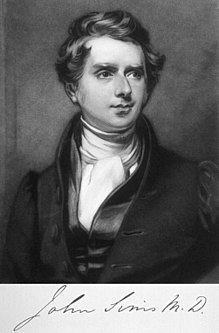
John Sims (13 October 1749 – 26 February 1831) was an English physician and botanist. He was born in Canterbury, Kent and was subsequently educated at the Quaker school in Burford, Oxfordshire, he then went on to study medicine at Edinburgh University. Later in life he moved to London (1766) where he worked as a physician, notably he was involved with the birth of Princess Charlotte in which both mother and baby died. He was the first editor of Curtis's Botanical Magazine.
Early life
Sims was born in Canterbury, Kent, the son of, Robert Courthope Sims (1720–1812), a physician, and Rebecca née Tritton (1723–c1781). His father was a member of the Society of Friends who published An Essay on the Nature and Constitution of Man . [1]
He was educated at the Quaker school in Burford, Oxfordshire, with additional instruction from his father. He studied medicine at Edinburgh University, obtaining his PhD in 1774. His dissertation was "De usu aquæ frigidæ interno."
Career
Medicine
He moved to London in 1766, where he worked as a physician at the Surrey Dispensary. He bought an obstetric practice in 1779, and was he was admitted to the Royal College of Physicians. [2] In 1780 he was appointed Physician and Man Midwife to the Charity for Delivering Poor Married Women at their own Houses. In 1817 he was called to the ill-fated childbirth of Princess Charlotte at which mother and baby died. [3]
Botany
He was the first editor of Curtis's Botanical Magazine (1801–1826 vols. xiv–xlii) after the death of the founder, William Curtis, [4] and edited Annals of Botany (1805–06) with Charles Konig. [2] He was a founding member of the Linnean Society. In March 1814 he was elected a Fellow of the Royal Society. [5]
His papers on botany include a description of the effect of moisture on Mesembryanthemum to the Medical and Physical Journal (vol. ii. 1799), and a "Description of Amomum exscapum" to the Annals of Botany (vol. i.). [2]
The genus name Simsia was published by the German Christiaan Hendrik Persoon in 1807, to honour Sims work. [6] [7] His herbarium was purchased by George Bentham and passed to the Royal Botanic Gardens, Kew.
Death
In 1825 he resigned from his medical practice and retired to Dorking, Surrey where he died in 1831. He is buried in Fittleworth, Sussex with his wife Ann née Christie (1765–1835) and their only son the Rev Dr Courthope Sims MD MB (1795–1833). [9]
References
- ^ Sims, Robert Courthope (1793). An Essay on the Nature and Constitution of man. London: James Phillips. p. 108. Retrieved 22 May 2016.
- ^ a b c Boulger, George Simonds (1885–1900). . Dictionary of National Biography. London: Smith, Elder & Co.
- ^ Crainz, Franco; Dewhurst, John (2005). "Dr John Sims-A mystery Solved". International Journal of Obstetrics and Gynaecology. 112 (7): 849–850. doi: 10.1111/j.1471-0528.2005.00566.x. PMID 15957982. S2CID 42027953.
- ^ "John Sims, 1749–1831". Darwin Project. Archived from the original on 27 September 2007. Retrieved 3 September 2007.
- ^ "Library and Archive Catalogue". The Royal Society. Retrieved 18 October 2010.[ permanent dead link]
- ^ Spooner, David M. "Simsia Persoon, Syn. Pl. 2: 478. 1807". Flora of North America. eFloras.org. Retrieved 30 December 2011.
- ^ "Simsia | International Plant Names Index". www.ipni.org. Retrieved 24 May 2021.
- ^ International Plant Names Index. Sims.
- ^ His will names his wife Ann, son Courthope and his daughters Clara, Caroline, Eglantine and Ann.
External links
- 1749 births
- 1831 deaths
- People from Canterbury
- 18th-century British botanists
- 18th-century English medical doctors
- English taxonomists
- Fellows of the Royal Society
- English Quakers
- Alumni of the University of Edinburgh
- 19th-century English medical doctors
- Physicians of the Surrey Dispensary
- 19th-century British botanists